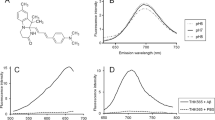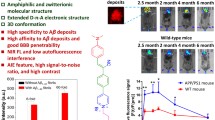Abstract
The treatment of Alzheimer’s disease (AD) has been hampered by a lack of sensitive and specific non-invasive diagnostic methods. Quantum dots (QD) are nano-crystals with unique photo-physical properties that bypass some of the limitations of conventional dyes and imaging tools. This study is aimed to evaluate the fluorescence properties of a QD probe conjugated with an anti-Aβ antibody (QD–Aβ-Ab). Healthy mice and mice bearing mutated human APP695swe and APP717 V-F transgenes received intracerebroventricular injection of the probe for subsequent imaging. Immunohistochemistry revealed that Aβ1–42 was distributed in the hippocampus CA1 area in the APP transgenic mice. Fluorescence microscopy demonstrated that fluorescence was mainly observed in the hippocampus area, the cerebral cortex, sagittal septum and striatum of APP transgenic mice. In vivo imaging of mice receiving the QD–Aβ-Ab probe showed that healthy mice exhibited a narrow range of fluorescence and lower fluorescence intensity compared with APP transgenic mice. The mean fluorescence intensity of brain tissues of healthy C57BL mice was 12.3784 ± 3.9826, which was significantly lower than that of 10- and 16-month-old APP transgenic mice (45.03 ± 2.66 and 46.69 ± 3.22, respectively; P < 0.05). In this study we present the first direct evidence that QD–Aβ-Ab conjugate probes can track in vivo state of Aβ accumulation in mice and the findings suggest that such probes may be of potential use for early molecular diagnostic imaging of AD.





Similar content being viewed by others
References
Ai X, Xu Q, Jones M, Song Q, Ding SY, Ellingson RJ, Himmel M, Rumbles G (2007) Photophysics of (CdSe)ZnS colloidal quantum dots in an aqueous environment stabilized with amino acids and genetically-modified proteins. Photochem Photobiol Sci 6:1027–1033
Alivisatos AP (1996) Semiconductor clusters, nanocrystals, and quantum dots. Science 271:933–937
Berchtold NC, Cotman CW (1998) Evolution in the conceptualization of dementia and Alzheimer’s disease: Greco-Roman period to the 1960s. Neurobiol Aging 19:173–189
Bermejo-Pareja F, Antequera D, Vargas T, Molina JA, Carro E (2010) Saliva levels of Abeta1-42 as potential biomarker of Alzheimer’s disease: a pilot study. BMC Neurol 10:108
Blennow K, Zetterberg H (2009) Use of CSF biomarkers in Alzheimer’s disease clinical trials. J Nutr Health Aging 13:358–361
Boche D, Denham N, Holmes C, Nicoll JA (2010) Neuropathology after active Abeta42 immunotherapy: implications for Alzheimer’s disease pathogenesis. Acta Neuropathol 120:369–384
Braak H, Braak E (1997) Frequency of stages of Alzheimer-related lesions in different age categories. Neurobiol Aging 18:351–357
Brookmeyer R, Johnson E, Ziegler-Graham K, Arrighi HM (2007) Forecasting the global burden of Alzheimer’s disease. Alzheimers Dement 3:186–191
Buchhave P, Minthon L, Zetterberg H, Wallin AK, Blennow K, Hansson O (2012) Cerebrospinal fluid levels of β-amyloid 1–42, but not of tau, are fully changed already 5 to 10 years before the onset of Alzheimer dementia. Arch Gen Psychiatry 69:98–106
Checler F, Buée L (2009) Fundamental data on the pathologies amyloid and Tau in Alzheimer’s disease: which therapeutic perspectives? Ann Pharm Fr 67:136–153
Chen Y, Xiong T, Yu L, Zeng S, Luo Q (2005) Whole-body fluorescent optical imaging based on power light emitting diode. Conf Proc IEEE Eng Med Biol Soc 2:1442–1445
Chen LD, Liu J, Yu XF, He M, Pei XF, Tang ZY, Wang QQ, Pang DW, Li Y (2008) The biocompatibility of quantum dot probes used for the targeted imaging of hepatocellular carcinoma metastasis. Biomaterials 29:4170–4176
Dahan M, Levi S, Luccardini C, Rostaing P, Riveau B, Triller A (2003) Diffusion dynamics of glycine receptors revealed by single quantum dot tracking. Science 302:442–445
Feng L, Li S, Xiao B, Chen S, Liu R, Zhang Y (2010) Fluorescence imaging of APP in Alzheimer’s disease with quantum dot or Cy3: a comparative study. Zhong Nan Da Xue Xue Bao Yi Xue Ban 35:903–909
Gao X, Cui Y, Levenson RM, Chung LW, Nie S (2004) In vivo cancer targeting and imaging with semiconductor quantum dots. Nat Biotechnol 22:969–976
Haute Autorité de Santée (2008) Diagnosis and management of Alzheimer’s disease and related diseases. Rev Neurol (Paris) 164:754–774
Jaiswal JK, Mattoussi H, Mauro JM, Simon SM (2003) Long-term multiple color imaging of live cells using quantum dot bioconjugates. Nat Biotechnol 21:47–51
Kasuga K, Tokutake T, Ishikawa A, Uchiyama T, Tokuda T, Onodera O, Nishizawa M, Ikeuchi T (2010) Differential levels of alpha-synuclein, beta-amyloid42 and tau in CSF between patients with dementia with Lewy bodies and Alzheimer’s disease. J Neurol Neurosurg Psychiatry 81:608–610
Kawas CH, Corrada MM, Brookmeyer R, Morrison A, Resnick SM, Zonderman AB, Arenberg D (2003) Visual memory predicts Alzheimer’s disease more than a decade before diagnosis. Neurology 60:1089–1093
Kim S, Swaminathan S, Shen L et al (2011) Genome-wide association study of CSF biomarkers Abeta1-42, t-tau, and p-tau181p in the ADNI cohort. Neurology 76:69–79
Perneczky R, Kurz A (2008) Diagnosis and therapy of Alzheimer’s disease: what’s important for the family doctor? MMW Fortschr Med 150:42–45
Selkoe DJ (2001) Alzheimer’s disease: genes, protein and therapy. Physiol Rev 81:741–766
Walling MA, Novak JA (2009) Shepard JR. Quantum dots for live cell and in vivo imaging. Int J Mol Sci 10:441–491
Xu G, Yong KT, Roy I, Mahajan SD, Ding H, Schwartz SA, Prasad PN (2008) Bioconjugated quantum rods as targeted probes for efficient transmigration across an in vitro blood-brain barrier. Bioconjug Chem 19:1179–1185
Acknowledgments
The study was supported by the National Natural Science Foundation of China (No. NNSF-30770736 and NNSF-81000553). The authors are grateful to Drs. Hui Gong. Zhaoyang Luo and Jianwei Fu from the Wuhan National Laboratory of Optoelectronics for providing optical instrumentation. The authors also thank Professor Xiaobo Zhu and Dr. Jun Peng from the College of Chemistry and Molecular Sciences, Wuhan University, for their constructive advice.
Author information
Authors and Affiliations
Corresponding author
Additional information
Li Feng and Hong-Yu Long contributed equally to this study.
Rights and permissions
About this article
Cite this article
Feng, L., Long, HY., Liu, RK. et al. A Quantum Dot Probe Conjugated with Aβ Antibody for Molecular Imaging of Alzheimer’s Disease in a Mouse Model. Cell Mol Neurobiol 33, 759–765 (2013). https://doi.org/10.1007/s10571-013-9943-6
Received:
Accepted:
Published:
Issue Date:
DOI: https://doi.org/10.1007/s10571-013-9943-6




